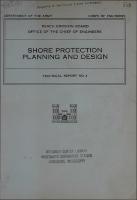Please use this identifier to cite or link to this item:
https://hdl.handle.net/11681/4385Full metadata record
| DC Field | Value | Language |
|---|---|---|
| dc.contributor.author | United States. Beach Erosion Board | - |
| dc.date.accessioned | 2016-03-16T19:44:02Z | - |
| dc.date.available | 2016-03-16T19:44:02Z | - |
| dc.date.issued | 1954-06 | - |
| dc.identifier.uri | http://hdl.handle.net/11681/4385 | - |
| dc.description | Technical Report | - |
| dc.description | Summary: This report has been prepared with a view to assembling in a single volume, insofar as practicable, a manual of practice for shore protection. The term "shore protection", as it is used herein, applies primarily to works designed to stabilize seacoasts and shores of large bodies of water where wave action is the principal cause of erosion. The nature and degree of protection required differ widely at different localities and the proper solution of any specific problem requires a systematic and thorough study. The first requisite for such a study is a clear definition of the problem and the objectives sought; the first factor to be determined in the course of the study is the cause of the problem. Ordinarily there will be more than one method of obtaining the immediate objective. In the study, therefore, the long term effects of each method should be forecast and evaluated, beyond as well as within the problem area. All advantages and effects should be considered in comparing annual costs and benefits to determine the justification of remedial measures. An attempt has been made to include herein a detailed summary of applicable methods, techniques and useful data pertinent to the solution of shore protection problems. Part I discusses the factors considered important in the analysis of such problems, beginning with the sources of energy and characteristics of material, proceeding with the interaction of these factors and ending with the development of functional plans. Part II presents generally accepted practice in structural design techniques for shore structures. Graphs and tables to facilitate computations and analysis are provided throughout the text and in appendices. Techniques presented herein are generally applicable to the broad scope of shore protection problems but competent engineering judgment is required for determining their application to any specific problem. As the meanings of terms used in coastal engineering differ from place to place, the reader is advised to make full use of Appendix A (Glossary of Terms). NOTE: This file is very large. Please allow your browser 5-6 minutes to download the file. Also note that the scanned document is extensively marked with marginalia. | - |
| dc.publisher | United States. Beach Erosion Board. | - |
| dc.publisher | Engineer Research and Development Center (U.S.) | - |
| dc.relation | http://acwc.sdp.sirsi.net/client/en_US/search/asset/1036842 | - |
| dc.relation.ispartofseries | Technical report (United States. Beach Erosion Board) ; no.4. | - |
| dc.rights | Approved for public release; distribution is unlimited. | - |
| dc.source | This Digital Resource was created from scans of the Print Resource | - |
| dc.subject | Shore protection | - |
| dc.subject | Shoreline protection | - |
| dc.subject | Beaches | - |
| dc.subject | Beach erosion | - |
| dc.subject | Handbooks and manuals | - |
| dc.title | Shore protection planning and design | - |
| dc.type | Report | en_US |
| Appears in Collections: | Technical Report | |
Files in This Item:
| File | Description | Size | Format | |
|---|---|---|---|---|
| BEB-TR-4.pdf | 89.35 MB | Adobe PDF |  View/Open |